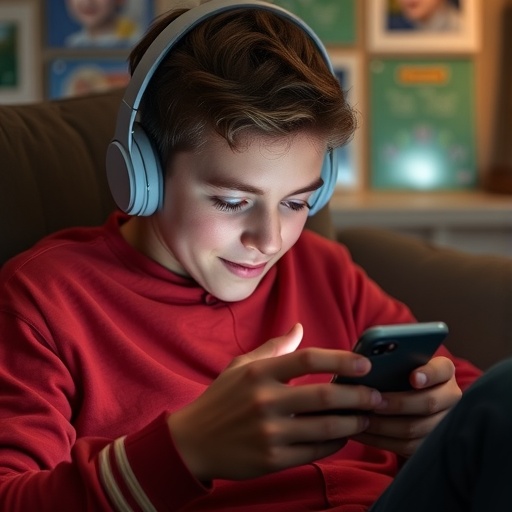In an era where smartphones have become ubiquitous, concerns about their overuse—particularly among adolescents diagnosed with attention-deficit hyperactivity disorder (ADHD)—are escalating. A groundbreaking new randomized controlled trial (RCT) spearheaded by researchers in Hong Kong aims to confront this issue head-on by developing a targeted intervention to mitigate smartphone overuse (SO) in this vulnerable demographic. Published in BMC Psychiatry, this study protocol outlines a comprehensive and technologically sophisticated approach to tackling the intertwined challenges of SO and ADHD symptoms.
Smartphone overuse has been widely documented as a pervasive phenomenon deeply affecting youths’ mental and physical well-being, as well as their academic and career prospects. Individuals with ADHD, characterized by symptoms such as inattention, impulsivity, and hyperactivity, have been consistently identified as being at higher risk for engaging in excessive smartphone use. Despite these risks, there remains a conspicuous absence of empirically validated interventions rigorously tested through randomized controlled trials specifically for individuals clinically diagnosed with ADHD.
The Hong Kong research team steps into this void with a methodology that integrates behavioral science, neurophysiological assessment, and individualized smartphone features. The study recruits 120 adolescents diagnosed with ADHD who exhibit problematic smartphone use. These participants are randomly assigned to one of two parallel arms: an intervention group receiving a 12-week smartphone-based behavioral program, and a control group engaged solely in self-monitoring their device usage.
What sets this study apart is its reliance on the smartphone itself as an intervention platform. The behavioral program leverages built-in functionalities—such as usage tracking, automated reminders, and tailored behavioral guidelines—to counteract smartphones’ addictive design elements. Weekly reminders add an element of accountability and personalized support, thereby aiming to sustainably promote healthier digital habits. Meanwhile, the control group’s self-monitoring activity provides a critical comparative baseline to evaluate the true impact of the intervention.
Another distinct dimension of this study is its comprehensive measurement strategy. Beyond tracking self-reported and objective smartphone use metrics, the researchers incorporate sophisticated neurophysiological tools—specifically resting-state electroencephalogram (EEG) recordings. These EEG assessments measure brain activity patterns when participants are exposed to smartphone-related salient stimuli versus neutral stimuli. This neuroimaging component aims to unravel the neural correlates of smartphone dependency and observe any intervention-induced modulations in brain function that could mirror clinical improvements.
Localizing the trial in Hong Kong adds cultural and contextual relevance, given the region’s intense smartphone penetration and academic pressures impacting youth. The study further includes multi-informant ADHD symptom assessments, incorporating ratings from both adolescents and their parents to ensure a robust evaluation of clinical outcomes. Measures are taken at three critical time points: before the intervention, immediately after its conclusion, and at a nine-month follow-up to assess durability of effects.
Importantly, this RCT intends not only to produce evidence for an effective intervention but also to clarify the causal pathways linking smartphone overuse and ADHD symptomatology. Previous research has established correlation but has left open vital questions about whether reducing SO can lead to meaningful improvements in ADHD-related behaviors and cognitive functioning. By integrating both behavioral and neural outcome markers, this study advances the field beyond descriptive associations towards mechanistic understanding.
From a public health perspective, the implications are extensive. A low-cost, scalable digital intervention can democratize access to care for adolescents struggling with co-occurring ADHD and smartphone overuse worldwide. By targeting maladaptive technology use patterns early, this approach promises to safeguard mental health trajectories, academic success, and overall quality of life. Moreover, insights gained about the brain’s response to smartphone cues may inspire novel treatment modalities blending digital therapeutics with neurofeedback or cognitive training.
The research team’s innovative use of technology highlights a broader paradigm shift in mental health interventions where the very devices contributing to behavioral problems become integral to their resolution. This smart, data-driven approach exemplifies precision psychiatry, tailoring interventions to individual usage patterns and neurocognitive profiles rather than adopting one-size-fits-all solutions.
Anticipation is high as this clinical trial unfolds, with the potential to fill a critical gap in evidence-based ADHD management while also contributing to a global discourse on healthy digital consumption. Publications stemming from the final outcomes could redefine clinical guidelines and influence policy on youth digital engagement. Furthermore, the trial’s rigor and methodological sophistication will set a new standard for interdisciplinary collaborations uniting psychiatry, neuroscience, and digital health technologies.
As smartphone ubiquity shows no sign of abating, targeted interventions like this are urgently needed to mitigate the risks of overuse, especially among populations with neurodevelopmental vulnerabilities like ADHD. The success of this trial may well catalyze further innovation in crafting personalized, accessible, and effective treatments for modern behavioral health challenges. Such research underscores the responsibility—and opportunity—of science to harness technology’s double-edged sword to foster healthier, more balanced lives.
The study’s registration on ClinicalTrials.gov (NCT07092787) as of July 2025 confirms its adherence to rigorous clinical research standards and transparency. With an expected timeline spanning immediate post-intervention through nearly a year-long follow-up, the trial promises comprehensive insights into both short-term benefits and long-term sustainability of behavior change.
In summation, this Hong Kong-based RCT exemplifies a timely and critical investigation into mitigating smartphone overuse in adolescent ADHD populations through a technologically savvy, behaviorally informed, and neurophysiologically grounded intervention. It promises to pioneer evidence-based strategies that align with the realities of digital-era mental health while advancing the scientific understanding of ADHD and its interaction with modern technology.
Subject of Research: Smartphone overuse reduction in adolescents with attention-deficit hyperactivity disorder (ADHD) using a smartphone-based behavioral intervention.
Article Title: Reducing smartphone overuse for adolescents with attention-deficit hyperactive disorder: study protocol for a randomized controlled trial.
Article References:
Yum, Y.N., Li, X., Poon, K.Y. et al. Reducing smartphone overuse for adolescents with attention-deficit hyperactive disorder: study protocol for a randomized controlled trial. BMC Psychiatry 25, 1043 (2025). https://doi.org/10.1186/s12888-025-07493-w
Image Credits: AI Generated




